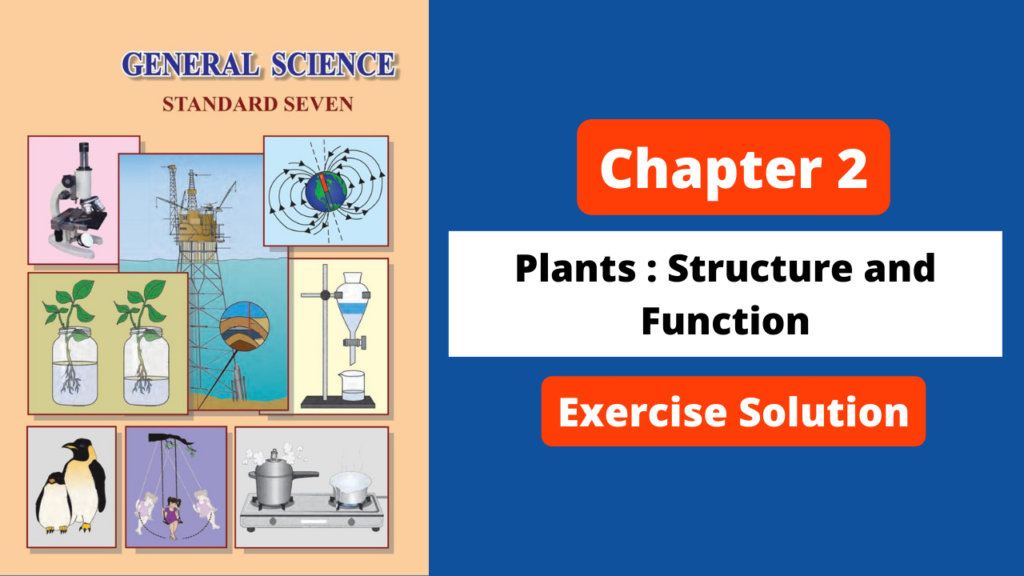
1. Find my match!
| ‘A’ Group | ‘B’ Group |
| (1) Lotus | (a) Flower and leaves attract insects |
| (2) Aloe | (a) Flowers and leaves attract insects |
| (3) Cuscuta | (c) Adapted to live in deserts |
| (4) Venus Flytrap | (d) Adapted to live in water |

2. Read the paragraph and answer the following questions:
I am a penguin. I live in the polar region covered by snow. My abdomen is white. My skin is thick with a layer of fat underneath. My body is spindle-a.
Questions:
(a) Why is my skin white and thick and why is there a thick layer of fat underneath?
- White skin colour camouflage with the snow so penguins cannot be easily spotted and they get protected from enemies.
- Thick skin and a thick layer of fat underneath protect them from severe cold.
(b) Why do we live in flocks sticking close to each other?
Penguins live in flocks sticking close to each other because sticking close to each other reduces the relative area so there is the least loss of heat and they get protection from the cold.
(c) Which geographical region do I inhabit? Why?
- Penguins inhabit the Antarctica region. Antarctica is surrounded by ocean. The climate is colder, drier and windier.
- It does not have a human population. This climate is suitable for penguins, so they inhabit Antarctica.
(d) Which adaptations should you have to enable you to live permanently in the polar region? Why?
- I should be a warm-blooded animal. This should allow me to live in the polar region permanently.
- My body has to be covered with thick fur or scale so that heat loss will be less and I can survive in severe cold.
3. Who is lying?
(a) Cockroach – I have five legs.
Answer: The cockroach is lying. It has six legs.
(b) Hen – My toes are webbed.
Answer: The hen is lying because the hen’s toes are not webbed. The duck has webbed toes.
(c) Cactus – My fleshy, green part is a leaf.
Answer: Cactus is lying. Its fleshy, green part is a stem, not a leaf.
4. Read each of the following statements. Write a paragraph about adaptation with reference to each statement.
(a) There is extreme heat in deserts.
Answer:
- The plant’s stem is fleshy, leaves get modified into thorns to reduce loss of water. Steam performs photosynthesis in the absence of leaves.
- Animals have cushioned soles, humps, long legs and nostrils that are protected by folds of skin. Eyelashes are long and thick.
(b) Grasslands are lush green.
Answer: Insects like grasshoppers have green colour so they can be camouflaged amidst grasses.
(c) We hide.
Answer: In the equatorial region grasses are very tall, so to protect themselves animals like tigers, elephants and deer remain hidden in these tall grasses.
(d) We have long ears.
Answer: It helps the animals to receive sounds from long distances, and they can protect themselves from predators.

5. Answer the following:
(a) Why is the camel called the ‘ship of the desert’?
Answer:
- Camel lives in a desert easily due to the following adaptations. It has long legs and cushioned soles which keep the body of the camel above the sand and the cushioned soles do not allow it to sink in the sand while walking.
- The nostrils are protected by folds of skin.
- The eyelashes are long and thick.
- It has a hump which stores fats so it helps camel to survive in the desert for many days without food and water.
Due to the above adaptations, camel is used to carry people and transport goods from one place to another place in the desert. Therefore, the camel is called the ship of the desert.
(b) How can the plants like cactus and acacia live in deserts with scarce water?
Answer:
Plants like cactus and acacia live in deserts with scarce water due to the following adaptations.
- Leaves are like small needles or have been modified into thorns, as a result, they lose very little water by evaporation.
- The stem stores water and food so it is fleshy.
- The stems are green as they perform photosynthesis in the absence of leaves.
- Their roots penetrate deep into the soil in search of water.
- There is a thick layer of a waxy substance on the stems.
(c) What is the inter-relationship between adaptations of organisms and their surroundings?
Answer:
- Adaptations of organisms depend on the changes in the surroundings.
- To adjust to those changes in the surroundings adaptation takes place gradually and continuously in organisms.
- Changes that take place in the various organs and life processes of organisms, enable them to live, feed, reproduce to perpetuate themselves and protect themselves from their enemies in specific surroundings, depending upon the habitat and its geographical conditions, are called adaptations.
(d) How are organisms classified?
Answer:
- Different scientists have used different criteria and independently classified plants and animals.
- A hierarchy is formed in the classification that starts with kingdom Animalia or kingdom Plantae, further groups and sub-groups are formed depending upon basic similarities and differences.
- This is called the ‘hierarchy of classification’.
- Binomial nomenclature is used to identify each organism. Accordingly, a scientific name has been assigned to each organism.
- It consists of two parts – the first part is ‘genus’ and the second is ‘species’.
- All identified organisms have been assigned a binomial name as per the guidelines of the International code of Nomenclature. For e.g.
| Genus | Species | |
| Mango | Mangifera | Indica |
| Human | Homo | Sapiens |
Activity: Find out how the gradual adaption from primitive man to modern man must have taken place.
The gradual adaptation from primitive man to modern man took place over millions of years through the process of evolution. Key stages include:
- Australopithecus (about 4 million years ago): Early hominins who walked on two legs.
- Homo habilis (about 2.4 million years ago): Known as “handyman,” they made simple stone tools.
- Homo erectus (about 1.9 million years ago): Developed more advanced tools, controlled fire, and possibly used basic language.
- Neanderthals (about 400,000 years ago): Adapted to cold climates, made complex tools and had a more robust build.
- Homo sapiens (about 300,000 years ago): Modern humans with advanced tools, art, culture, and language.
Each stage involved physical and behavioural changes that improved their ability to survive and adapt to their environments.


